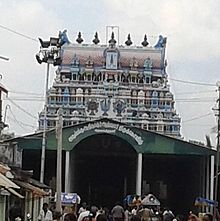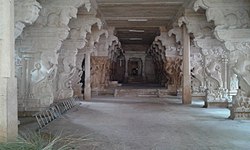
Nammalvar was one of the twelve Alvar saints of Tamil Nadu, India, who are known for their affiliation to the Vaishnava tradition of Hinduism. The verses of the Alvars are compiled as the Naalayira Divya Prabandham, where praises are sung of 108 temples that are classified as divine realms, called the Divya Desams. Nammalvar is considered to be the fifth in the line of the twelve Alvars. He is highly regarded as a great mystic of the Vaishnava tradition. He is also considered to be the foremost among the twelve Alvars, and his contributions amount to 1352 among the 4000 stanzas in the Naalayira Divya Prabandam.

Madhurakavi Alvar was one of the twelve Alvars saints of South India, who are known for their affiliation to Vaishnava tradition of Hinduism. The verses of the Alvars are compiled as the Naalayira Divya Prabandham and the 108 temples revered are classified as Divya Desams. Madhurakavi is considered to be the sixth in the line of the twelve Alvars. He was the disciple of Nammalvar, considered to be the greatest among the twelve Alvars, his contributions amounting to 11 among the 4000 stanzas in the Naalayira Divya Prabandam. Madhurakavi is believed to have recorded and compiled the works of Nammalvar, the Tiruvaymoli. The 11 verses of Kanninun Cirutampu composed by Madhurakavi Alvar may be considered to be the inspiration for the 4000 verses of Naalayira Divya Prabandham. These verses were chanted by Nathamuni 12,000 times to propitiate Nammalvar and re-obtain the lost Naalayira Divya Prabandham from Nammalvar.

The Deepaprakasa Perumal Temple, also referred to as Tiruththanka, and Tooppul, is located in Kanchipuram in the South Indian state of Tamil Nadu, is a temple dedicated to the Hindu god Vishnu. Constructed in the Dravidian style of architecture, the temple is glorified in the Naalayira Divya Prabandham, the early medieval Tamil canon of the Alvar saints from the 6th–9th centuries CE. It is one of the 108 Divya Desams dedicated to Vishnu, who is worshipped as Deepaprakasar, and his consort Lakshmi as Maragathavalli.
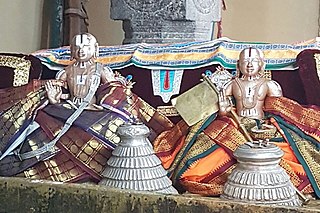
Nathamuni, also known as Sri Ranganathamuni,, was a Vaishnava theologian who collected and compiled the Naalayira Divya Prabandham.

The Purushotama Perumal Temple is located in Thirunangur, a village in the outskirts of Sirkazhi in the South Indian state of Tamil Nadu, and is dedicated to the Hindu god Vishnu. Constructed in the Dravidian style of architecture, the temple is glorified in the Nalayira Divya Prabandham, the early medieval Tamil canon of the Alvar saints from the 6th–9th centuries CE. It is one of the 108 Divya Desams dedicated to Vishnu, who is worshipped as Purushottaman and his consort Lakshmi as Purushottama Nayagi.

Thiruthevanartthogai or Madhava Perumal Temple is a Hindu temple dedicated to Vishnu located in Tirunangur, a village in the outskirts of Sirkaḻi in the South Indian state of Tamil Nadu. Constructed in the Dravidian style of architecture, the temple is glorified in the Nalayira Divya Prabandham, the early medieval Tamil canon of the Alvar saints from the 6th–9th centuries CE. It is one of the 108 Divya Desams dedicated to Vishnu, who is worshipped as Madhava Perumal and his consort Lakshmi as Kadalmagal.

Thiruthetriyambalam or Palli Konda Perumal Temple is located in Tirunangur, a village in the outskirts of Sirkaḻi in the South Indian state of Tamil Nadu, is dedicated to the Hindu god Vishnu. Constructed in the Dravidian style of architecture, the temple is glorified in the Nalayira Divya Prabandham, the early medieval Tamil canon of the Alvar saints from the 6th–9th centuries CE. It is one of the 108 Divya Desams dedicated to Vishnu, who is worshipped as Palli Konda Perumal.

Thirumanikkoodam or Varadaraja Perumal Temple is located in Thirunangur, a village in the outskirts of Sirkaḻi in the South Indian state of Tamil Nadu. It is dedicated to the Hindu god Vishnu. Constructed in the Dravidian style of architecture, the temple is glorified in the Nalayira Divya Prabandham, the early medieval Tamil canon of the Alvar saints from the 6th–9th centuries CE. It is one of the 108 Divya Desams dedicated to Vishnu, who is worshipped as Varadharaja Perumal.
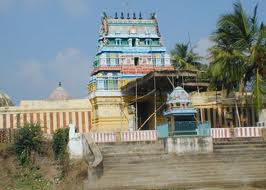
Thiruvellakkulam is a Hindu temple dedicated to Vishnu located in Thirunangur, a village in the outskirts of Sirkazhi in the South Indian state of Tamil Nadu. Constructed in the Dravidian style of architecture, the temple is glorified in the Nalayira Divya Prabandham, the early medieval Tamil canon of the Alvar saints from the 6th–9th centuries CE. It is one of the 108 Divya Desams dedicated to Vishnu, who is worshipped as Annan Perumal and his consort Lakshmi as Alamermangai.

Thanjai Mamani Koil is a set of three adjacent Hindu temples dedicated to Vishnu located in Thanjavur, Tamil Nadu, India. It is one of the Divya Desams, the 108 temples of Vishnu revered by the 12 poet saints called the Alvars. Unlike other Divya Desams where a single shrine is referenced, this set of temples is referred together in all the pasurams.

Srivaikuntanathan Perumal Temple in Srivaikuntam, a town in Thoothukudi district in the South Indian state of Tamil Nadu, is dedicated to the Hindu god Vishnu. It is located 22 km from Tirunelveli. Constructed in the Tamil style of architecture, the temple is glorified in the Nalayira Divya Prabandham, the early medieval Tamil canon of the Alvar saints from the 6th–9th centuries CE. It is one of the 108 Divya Desams dedicated to Vishnu, who is worshipped as Vaikunthanathar and his consort Lakshmi as Vaikunthavalli. The temple is also classified as a Nava Tirupati, the nine temples revered by Nammalvar located in the banks of Tamiraparani river. The temple is next only to Alwarthirunagari Temple in terms of importance among the nine Navatirupathi temple. The temple is one of the Navagraha temples in Vaishnavism, associated with Surya, the sun god.

Thiruvaragunamangai Perumal Temple is one of the Nava Tirupati, the nine Hindu temples dedicated to Vishnu located in the Tiruchendur-Tirunelveli route, Tamil Nadu, India in the banks of Thamiraparani river. All these 9 temples are classified as Divya Desams, the 108 temples of Vishnu revered by the 12 poet-saints of the Sri Vaishnava tradition, called the Alvars. The temple at Natham also known Chandran Sthalam, the second of the Nava Tirupatis. Constructed in the Dravidian style of architecture, the temple is dedicated to Vishnu who is worshipped as Vijayasana Perumal and Lakshmi as Varagunavalli.

The Thirupuliangudi Permual Temple is one of the Nava Tirupati, the nine Hindu temples dedicated to Vishnu located in Tiruchendur-Tirunelveli route, Tamil Nadu, India in the banks of Thamiraparani river, in the South Indian state of Tamil Nadu. It is dedicated to the Hindu god Vishnu who is worshipped as Bhumipalar and Lakshmi as Pulingudivalli. It is located 22 km from Tirunelveli. Constructed in the Dravidian style of architecture, the temple is glorified in the Nalayira Divya Prabandham, the early medieval Tamil canon of the Alvar saints from the 6th–9th centuries CE. It is one of the 108 Divya Desams dedicated to Vishnu. The temple is also classified as a Nava Tirupati, the nine temples revered by Nammalvar located in the banks of Tamiraparani river. The temple is one of the Navagraha temples in the region, associated with Budha.

Irattai Tirupati Temple refers to two temples of the Nava Tirupati, namely Devapiran temple and Aravindalochanar temple dedicated to Vishnu located in Tiruchendur-Tirunelveli route, Tamil Nadu, India in the banks of Thamiraparani river. All these 9 temples are classified as "Divya Desams", the 108 temples of Vishnu revered by the 12 poet saints Alvars. The two temples are located adjacent to each other. All these 9 temples of the Nava Tirupati are also classified as "Divya Desams", the 108 temples of Vishnu revered by the 12 poet-saints called the Alvars. The Irattai Tirupati is a Ketu Sthalam, sacred to the deity Ketu. Constructed in the Dravidian style of architecture, the temples are dedicated to Vishnu who is worshipped as Devapiran and Aravindalochanar and Lakshmi as Varagunavalli and Karuthadankanni.

Sri Srinivasa Perumal Temple or Sri Mayakoothar Permual Temple is one of the Nava Tirupatis, nine Hindu temples dedicated to Vishnu located Perungulam along Tiruchendur-Tirunelveli route, Tamil Nadu, India in the southern bank of Thamiraparani river. It is located 5 km from Alvar Thirunagari. All these 9 temples are classified as Divya Desams, the 108 temples of Vishnu revered by the 12 poet-saints of Sri Vaishnavism called the Alvars. The temple is referred to as Shani sthalam, a location for the planet deity, Shani (Saturn). Constructed in the Dravidian style of architecture, the temple is glorified in the Nalayira Divya Prabandham, the early medieval Tamil canon of the Alvar saints from the 6th–9th centuries CE. It is one of the 108 Divya Desams dedicated to Vishnu, who is worshipped as Mayakoothar and his consort Lakshmi as Kulandhaivalli Tayar.

The Makara Nedunkuḻaikathar Temple is one of the Nava Tirupathi, nine Hindu temples dedicated to Vishnu located Thenthiruperai along Tiruchendur-Tirunelveli route, Tamil Nadu, India in the southern bank of Thamiraparani river. It is located 5 km from Alvar Thirunagari All these 9 temples are classified as Divya Desams, the 108 temples of Vishnu revered by the 12 poet saints, or Alvars. The temple is referred to as Sukra sthalam, a location for the planet deity, Sukra. Constructed in the Dravidian style of architecture, the temple is glorified in the Nalayira Divya Prabandham, the early medieval Tamil canon of the Alvar saints from the 6th–9th centuries CE. It is one of the 108 Divya Desams dedicated to Vishnu, who is worshipped as Makara Nedunkuḻaikathar and his consort Lakshmi as Tiruperai Nachiyar.

Vaithamanidhi Permual Temple is one of the nine Nava Tirupathi, the Hindu temples dedicated to Vishnu. It is located on the Tiruchendur–Tirunelveli route in Tamil Nadu, India, on the southern bank of the Thamiraparani River, 4 km from Alwarthirunagari. It is the eighth temple of Nava Tirupathi, and is named after Mars (Sevvai) and also called Kuberasthalam. Constructed in the Dravidian style of architecture, the temple is glorified in the Nalayira Divya Prabandham, the early medieval Tamil canon of the Alvar saints from the 6th–9th centuries CE. It is one of the 108 Divya Desams dedicated to Vishnu, who is worshipped as Vaithamanidhi Perumal and his consort Lakshmi as Kolurvalli.

The Devapiran Perumal Temple, also known as Thirutholaivillimangalam Irettai Thirupathi Sri Srinivasa Perumal Temple in Tholavillimangalam, a village in Thoothukudi district in the South Indian state of Tamil Nadu, is dedicated to the Hindu god Vishnu. It is located 22 km from Tirunelveli. Constructed in the Dravidian style of architecture, the temple is glorified in the Nalayira Divya Prabandham, the early medieval Tamil canon of the Alvar saints from the 6th–9th centuries CE. It is one of the 108 Divya Desams dedicated to Vishnu, who is worshipped as Devapiran and his consort Lakshmi as Karunthadankanni. The temple is also classified as a Nava Tirupati, the nine temples revered by Nammalvar located in the banks of Tamiraparani river. Along with the Aravindalochanar temple located 100 yards away, the temple is referred as Irattai Tirupati. This temple is a Ketu Sthalam, housing a shrine to the deity Ketu.

The Aravindalochanar Perumal Temple in Tholavillimangalam, a village in Thoothukudi district in the South Indian state of Tamil Nadu, is dedicated to the Hindu god Vishnu. It is located 22 km from Tirunelveli. Constructed in the Dravidian style of architecture, the temple is glorified in the Nalayira Divya Prabandham, the early medieval Tamil canon of the Alvar saints from the 6th–9th centuries CE. It is one of the 108 Divya Desams dedicated to Vishnu, who is worshipped as Aravindalochanar and his consort Lakshmi as Karunthadankanni. The temple is also classified as a Navatirupathi, the nine temples revered by Nammalvar located in the banks of Tamiraparani river. Along with the Devapiran temple located 100 yards away, the temple is referred as Irattai Tirupati. This temple is associated with the mythological Rahu, and is called a 'Rahu Sthalam.'
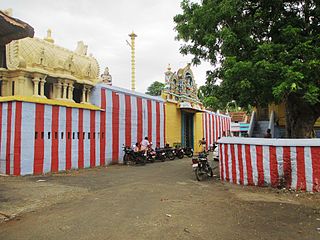
The Thiruvazhmarban Temple, also known as Sri Kuralappa Perumal Temple in Thiruppathisaram, a village in Kanyakumari district in the South Indian state of Tamil Nadu, is dedicated to the Hindu god Vishnu. Thiruvazhmarban Temple is located about 5 km far, north-easterly to Nagercoil, 20 km far, north-westerly to Kanyakumari and 45 km south-west of Nanguneri Divya Desam. Constructed in the Dravidian style of architecture, the temple is glorified in the Nalayira Divya Prabandham, the early medieval Tamil canon of the Alvar saints from the 6th–9th centuries CE. It is one of the 108 Divya Desams of malayala nadu divyadesham dedicated to Vishnu, who is worshipped as Thiruvazhmarban and his consort Lakshmi as Kamalavalli in kerala tantric traditions. The oldest inscription in the temple is from 1139 CE indicating gifts to the temple. A granite wall surrounds the temple, enclosing all its shrines. The temple tank is located opposite to the temple, outside the main entrance.
